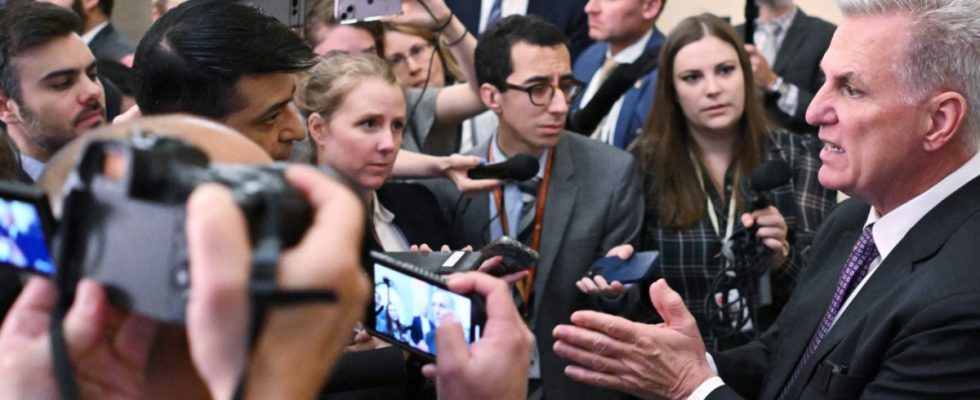For Joe Biden, it’s a quick return to the rough grind of domestic politics. From the G-7 summit in Japan, the US President will be meeting with Kevin McCarthy on Monday. Biden is negotiating the debt ceiling with the Republican speaker of the House of Representatives. The stakes are high: preventing the United States from defaulting and global confidence in the political actors of the world’s largest economy falling further. Not much time left: According to Treasury Secretary Janet Yellen, the US only has money for a few days.
What exactly is the debt ceiling?
Actually, the “debt ceiling” is a technical matter. The debt ceiling is the maximum amount that the US government can borrow. Congress sets it and the amount – currently $31.4 trillion – can only be increased with the consent of both chambers, i.e. the Senate and the House of Representatives. Before 1917, MPs had to approve any new borrowing. The debt ceiling was intended to give the executive branch more leeway – and at the same time prevent the United States from having to borrow too much money as a result of participating in the First World War.
Due to the veto power of Congress and the growing polarization, there are regular power struggles between Democrats and Republicans over the debt ceiling. That’s how it is now, because the Republicans have controlled the House of Representatives since the beginning of 2023. The new “speaker” McCarthy does not begrudge Biden any success before the presidential election and has to prove himself to his own party. Actually, the limit of 31.4 trillion dollars was already reached in January. However, the Treasury has room to buy a few months with accounting tricks and “extraordinary measures”. According to Yellen, this period ends on June 1st.
What strategy is the White House pursuing?
On Sunday, Biden called McCarthy from the Air Force One at. The Republican called the call “productive”. That’s not a bad sign. But the poker goes on: McCarthy emphasized that the two positions are still far apart. Originally, Biden had called for Congress should raise the debt ceiling without discussion. His argument: MPs would already decide on all government spending. With his 36 years of experience as a senator, Biden will have known that he would not get away with it. The Democrats are now ready to cut spending, as the Republicans have asked for. In Hiroshima, Biden said the Republicans had to give up their “extreme positions”. However, the US President seems open to tightening some rules for recipients of social benefits (“work requirements”). But the whole package has to be right.
However, during his stay in Japan, the 80-year-old emphasized that there were limits to his willingness to compromise: he would not enter into a deal from which the pharmaceutical industry benefits, protects “rich tax fraudsters and traders in cryptocurrencies”. and teachers, as well as the socially disadvantaged. Biden isn’t just saying that because he wants to be elected in 2024 — he needs to find a compromise supported by Democratic senators and lawmakers. According to US media, Biden’s advisors expectthat voters are less interested in the details. Instead, they will give the incumbent credit for leadership if he averts the financial crisis despite threats from radical Republicans.
What are the Republicans’ demands?
Government spending should decrease. There should only be exceptions for defense and social security. For example, the Republicans want to stop expensive programs to promote climate protection measures. McCarthy, who was only elected speaker in the 15th ballot and whose party only has a narrow majority, is under pressure from several sides. On the one hand, companies, investors and associations are warning of the insolvency of the USA – nothing like this has happened in 230 years. On the other hand, the hardliners of the “Freedom Caucus” are demanding that no concessions be made. Ex-President Donald Trump made a similar statement on his Truth social platform: “Republicans shouldn’t make a deal on the debt ceiling until they get everything they want.” McCarthy also needs successes that he can point to.
Can a country like the US ever go bankrupt?
The short answer is no. Since the US has its own currency and does not owe money in euros or yen, the Federal Reserve (Fed) can theoretically print unlimited dollars to pay off debts at home and abroad. But what can happen: The country becomes temporarily insolvent – namely if the government does not take out new loans because of the debt ceiling and the Fed does not make any funds available may. Since it is also known on the financial markets that the dispute is not an economic but a political problem, there should be no chaos on the stock exchanges even if payments were stopped.
What would be the consequences of a temporary insolvency?
Many public sector employees could temporarily lose their jobs, pensioners and the socially disadvantaged would have to wait days or weeks for their payments. State projects would also be stopped and investments postponed. Above all, however, the major rating agencies could downgrade the creditworthiness of the USA. In the event of a downgrade, the US may have to pay more interest on government bonds in the future than it has in the past. This would add billions to the budget. A high price to pay for a petty dispute.

